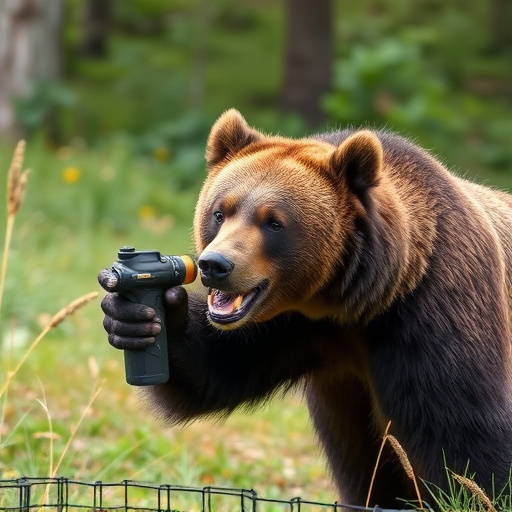Understanding bear behavior is key for effective deterrence using bear spray, which leverages capsaicin—a key ingredient from chili peppers—to temporarily disrupt bears' exceptional sense of smell. The capsaicin concentration (10% to 20%) determines the strength and range of protection, with higher levels offering better results. Factors like weather and terrain can impact performance, while selecting a spray with a robust capsaicin level and practical features ensures safety during outdoor activities in bear-inhabited areas.
In bear country, ensuring maximum range protection from these formidable creatures is paramount. This article delves into the science behind bear deterrent sprays, specifically focusing on capsicin as the active ingredient. We’ll explore how understanding bear behavior and their acute sense of smell informs the effectiveness of these products. Factors influencing spray range are dissected, along with considerations for choosing the right bear deterrent spray for optimal protection during outdoor adventures. Key focus: capsacin concentration in bear repellent.
- Understanding Bear Behavior and Their Sense of Smell
- The Science Behind Capsaicin: Active Ingredient in Bear Deterrent Spray
- Factors Affecting the Range and Effectiveness of Bear Repellent Spray
- Choosing the Right Bear Deterrent Spray: Considerations for Maximum Protection
Understanding Bear Behavior and Their Sense of Smell
Understanding bear behavior is key when it comes to deterring them with spray. Bears possess an exceptional sense of smell, which plays a crucial role in their survival and navigation. They use scent to locate food, mark territory, and communicate with other bears. When faced with potential threats, they often retreat rather than attack unless they feel cornered or their cubs are in danger. This instinctual behavior is where the effectiveness of bear deterrent spray lies—by overwhelming their sense of smell, it can create a perception of danger and prompt them to avoid an area.
The capsaicin concentration in bear repellent is a significant factor. Capsaicin, the active ingredient found in chili peppers, irritates the mucous membranes in a bear’s nose and eyes, temporarily impairing their olfactory capabilities. A high-quality spray with a strong capsaicin concentration can provide maximum range protection, ensuring that bears detect the spray as an unpleasant deterrent even from a distance. This strategic approach to bear deterrence allows outdoor enthusiasts and residents in bear country to minimize conflict and enjoy their surroundings safely.
The Science Behind Capsaicin: Active Ingredient in Bear Deterrent Spray
The active ingredient in bear deterrent spray, capsicum or capsaicin, is a natural compound derived from chili peppers. Its effectiveness as a bear repellent lies in its ability to trigger a sensory response in the animal’s nervous system. Capsaicin creates a burning sensation and irritates the eyes, nose, and respiratory tract of bears, causing them to avoid the area.
The concentration of capsicum in these sprays varies, but it is typically measured in percentages. A higher concentration means stronger irritation and increased protection against bears. Bear repellent sprays with a capsaicin concentration between 10% and 20% are common, offering a balance between effectiveness and user safety. This natural compound is non-toxic to humans when used appropriately and provides a safe, environmentally friendly alternative to other bear deterrents.
Factors Affecting the Range and Effectiveness of Bear Repellent Spray
The range and effectiveness of bear deterrent spray are influenced by several key factors. One of the most critical is the capsaicin concentration, a chemical compound derived from chili peppers that triggers a burning sensation in the bear’s eyes and nose, causing it to retreat. Higher concentrations of capsaicin generally result in increased range and potency, as it can deter bears from a farther distance.
Other factors include weather conditions, such as wind and temperature, which can impact the spray’s aerodynamic properties and its ability to reach and irritate the bear. Terrain also plays a role; in dense forests or rugged landscapes, the spray may not travel as far due to obstructions and variable air currents. Moreover, the distance at which the spray is effective can vary based on the size and aggressiveness of the bear, with larger bears potentially requiring higher concentrations or closer proximity to be deterred.
Choosing the Right Bear Deterrent Spray: Considerations for Maximum Protection
When selecting a bear deterrent spray, understanding the capsaicin concentration is key to ensuring maximum protection. Capsaicin, the active ingredient in many bear repellents, works by irritating the animal’s olfactory system, making it an effective and humane deterrent. The strength of the solution directly correlates with its range and effectiveness; higher concentrations provide a longer reach and stronger deterrence against bears.
Other considerations include the spray’s nozzle type, weather resistance, and ease of use. A can with a precision nozzle allows for targeted application, reducing waste and ensuring the spray reaches its intended distance. Weatherproof designs are ideal for outdoor adventures in varying climates, while easy-to-use mechanisms enable quick deployment during unexpected encounters. Choosing a bear deterrent spray that combines a robust capsaicin concentration with these practical features offers the best chance at keeping you safe in bear country.
The optimal range and effectiveness of bear deterrent spray depend on various factors, including capsaicin concentration, weather conditions, and terrain. Understanding these elements allows users to make informed decisions when choosing a bear repellent. The active ingredient, capsaicin, plays a pivotal role in deterring bears due to its strong sensory properties. By selecting a spray with the right capsaicin concentration tailored to specific needs, individuals can enhance their safety while exploring bear country. Remember, combining knowledge of bear behavior and using effective repellents is key to navigating these wild encounters.
